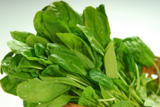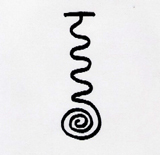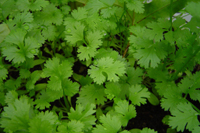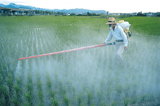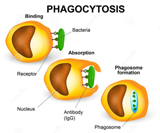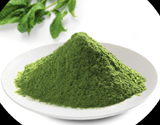Nutrition and diet
Growing leafy vegetables with Photobionics
Abstract
Leafy vegetables are rich in several nutritious substances. At the same time, these foodstuffs are prone to maximum chemical contamination as they are consumed soon after the use of chemical manures and pesticides. These experiments with photobionic potencies provide an easy alternative to this problem and these methods can be tried even in our own backyard or roof garden.
A brief review of Photobionics
Photobionics is the science that works on the basis of the spiritual truth that all matter is the condensation of cosmic light of varying frequencies. This celestial light as it flows down fills each of the worlds (called variously as heavens, planes or loka in Sanskrit) and organises itself in patterns visible to the occult eye in the form of intuitions or revelations. The mind and senses, when purified of the movements of lower nature, can receive and reflect this light which shapes itself as various forms and symbols that rule over and determine terrestrial eventuality and existence. A dedicated exploration of this occult existence brings us closer to the cosmic energies that channel themselves through whorls, vortices and serpentine movements known as kuṇḍalinī in spiritual parlance.
A detailed study of the Nature and Self as a part of sadhana revealed that this kuṇḍalinī exists in plants, animals and human beings alike and evolves in its shape and details along with biological evolution. Even more interesting is the fact that this revelation brought along with it the notations and symbols of chemistry to represent various descending, ascending and whirling movements of this kuṇḍalinī. An exhaustive study of biochemistry in botany and zoology is being taken up to draw parallels between modern science which explains various metabolic processes as cycles and pathways traversed by biochemical substances and tantric science which predicts and harmonises the movements of cakras and nāḍīs as a part of yoga.
Though a large part of this knowledge has still to be worked out, it was incidentally recognised that this knowledge can be readily applied on plants. Nature, in its operations, follows two chief principles — bringing close either similars or dissimilars. While bringing close the similars causes an increase of them, bringing close the dissimilars leads to their ultimate reduction (1). The first principle is being called by the name homoeopathy and the second by the name allopathy whereas Āyurveda uses both these principles according to their appropriate utility. Photobionics works on the basis of the homoeopathic law of similars.
In homoeopathic medicines, the serial dilution of a substance in universal solvents like alcohol or water, potentisation as it is called, allows the substance to imprint its essential behavioural patterns(determined by its nucleus) along the homogenously bonded molecular chains of the solvent. This imprint can replicate itself in every homogenous medium endlessly, of course as a memory of its shape, even when the original substance from which this shape is copied is no more present. Yogic knowledge attributes this ‘memorising capacity‘ of the solvents to the predominance of jala prakṛti, one of the five elemental conditions of Matter. By this process of potentisation, the substance gains a ready access into the vital zone (2) as it transcends the physical barriers of size (mahima) and weight (garimā).
An intuitive study of the growth of various tissues of plants from their germ layers revealed that these tissues dynamically evolve along a gradient and the growth of each tissue can be attributed to the activity of a particular cakra (3). A course of medicines that has to be used along the life cycle of the plant in order to promote a healthy and harmonised growth can be systematically devised. By spraying these medicines in potentised form, the life process of these plants can be stimulated. This is the idea behind applying Photobionics on plants.
Recent experiments on leafy vegetables
Growing paddy with the photobionic method gave good results (3),(4),(5). An attempt to grow all other vegetables using a similar method is now being aimed at. As a first step, an experiment on leafy vegetables was taken up. Usually leafy vegetables take 15-20 days to grow to optimum size. We proceeded with our experiments by first soaking the seeds in potentised medicine prepared with distilled water. Then we sprayed medicines identified intuitively based on the cakra-dependent classification of plant tissues (3).
The following plants were selected for our experiment:
Spinach (palakura in Telugu)
Coriander (kothimeera in Telugu)
Preparation of medicines
The 32c potency of the medicine used has to be prepared using distilled water as the vehicle. 30c potency made with ethyl alcohol can be used as back potency for this. This is further diluted in canal water or water from a bore well in the ratio of 1:10 and stirred 100 times in a bucket or a suitable container and is sprayed on the plants.
Formula of medicines used
The formula for all plants was the same because our aim was only to see the healthy growth of leaves and not to study the plant growth all through its life cycle though that may have to be done in the future to collect viable seeds.
1. For priming the seeds, we soaked them in Magnesium sulph 32c for 1hour and then dried them for another ½ to 1hour before sprinkling them in the seed beds.
2. We sprayed Magnesium sulph 32c, Sulphuric acid 32c and Urea 32c keeping in view the following biological changes in the plants:
Magnesium sulph 32c to promote easy sprouting of seeds by activating photosynthesis. Seeds with a thick outer coat can be soaked in Urea 32c for 15-30 minutes first to allow the easy dissolution of the outer coat and then they are to be soaked in Magnesium sulph 32c.
On spraying Sulphuric acid 32c, the leaves which are yellowish owing to deficiencies of various kinds turned green within 1-2 days. It is intuitively observed that Sulphuric acid in potentised form dissolves the barriers that prevent the flow of xylem contents to leaves and thus promotes its life activity.
Urea 32c to promote the overall growth of the plant.
Results
The outcome was very satisfactory. The leaves appeared fresh and healthier when compared to the other plants for which chemical manures and pesticides had been used. The most satisfying thing was that the shelf-life of these plants was up to 10-15 days when refrigerated whereas the plants treated with manure and pesticides usually wilt within 3-4 days.
However, after a number of successive trials, we found that the surface soil was getting unhealthy and pests and caterpillars started attacking the plants making pores on leaves. This condition cannot be met with photobionic methods as these medicines aid the improvement of the health of the plant alone and cannot repel unwanted life. We found the solution for these pests in Jīvāmṛtam, a domestically prepared pest-repellent using cow urine. This helped in the restoration of normal pH of the soil and in preventing the invasion of pests. It is prepared as follows:
About ½ kg of cow dung mixed in 50 litres of water. In this mixture, ½ litre of cow urine, ½ kg of jaggery,1/2 kg of corn flour and a little of clay also are mixed and allowed to ferment for 2 days. Occasional stirring of this solution helps in proper mix of these ingredients. After 2 days, the solution that is collected from filtering it with a cloth is called Jīvāmṛtam which can be readily sprayed on plants. Usually this solution has to be used within 1week of its preparation.
Laboratory analysis
A biochemical analysis of the antioxidant activity of these plants was also taken up. The comparision was done by estimating the DPPH scavenging potential of commercial and photobionically grown spinach and coriander respectively.
Significance of the laboratory test selected
The process of digestion is not limited to the gut alone because every cell is exposed to digestive enzymes produced within it and around it, which eat away unwanted proteins. When this digestive process exceeds a limit, it leads to cell lysis (phagocytosis) and cell death (apoptosis). Free radicals are the highly reactive chemical molecules, atoms or ions which are precisely at work for the same reason, i.e. digestion and ultimate lysis of unwanted proteins in each cell.
The liver is the major organ involved in recycling the broken cellular material (by means of apoptosis) in order to re-use it in cell building or excrete it. Next to it come the spleen (called as the graveyard of red blood cells1 where haem proteins and other minerals are oxidised and recycled), then the kidneys (which re-absorb important electrolytes and maintain the pH balance of the whole body which determines the rate and direction of a chemical reaction) and the small intestines and finally the large intestines including the rectum (which separate digested and undigested parts of the food as well as our own white blood cells2 which are to be recycled after apoptosis). It is because of the action of free radicals along with other digestive enzymes that all this recycling takes place. If the right chemical environment is maintained, these free radicals can be prevented from attacking the cells and the painstaking process of cell destruction and reconstruction can be avoided.
It is found that in diseased conditions especially of the liver, this free radical activity is heavily increased leading to cell death and destruction at a rapid rate. For example, nitric oxide free radicals are the major group causing liver damage in liver diseases or alcoholism.
Antioxidants are the substances which attach themselves to the free radicals by taking away the loose electrons and make them impotent to attack the cell proteins, thereby minimising cell destruction and death. Several antioxidant enzymes like the super oxide dismutase, glutathione reductase, etc., scavenge the released free radicals and prevent/reduce the rate of cell lysis. Hence nutritionists advise taking foods rich in antioxidants to promote health and fight ageing and disease.
DPPH(Diphenyl Picryl Hydrazyl) is a chemical substance composed of free radical molecules. By exposing the photobionically grown and chemically grown foods to DPPH, it is possible to calculate the percentage of antioxidants present in these foods by assessing the rate at which they scavenge the free radicals.
Method of analysis
Hot aqueous extracts of leafy vegetables were used for the study. Shade-dried plant material was powdered and extracted by a hot extraction method. Solvent (distilled water) 10 times the weight of the extract was taken and boiled to a concentrate of 1/10th of the original mixture. The extract was filtered and cooled to room temperature.
Different concentrations of the extract were prepared and radical scavenging activity was evaluated using Colorimetry (UV-Visible spectroscopy) at 517 nm.
By observing the % inhibition of DPPH radicals by different concentrations of extracts their antioxidant ability was compared.
Concentration |
Spinach |
Coriander |
|||
Commercial |
Photobionic |
Commercial |
Photobionic |
||
2% |
Absorbence3 |
0.175 |
0.15 |
0.135 |
0.13 |
% inhibition |
11.16 |
23.85 |
31.47 |
34.01 |
|
10% |
Absorbence |
0.14 |
0.111 |
0.087 |
0.085 |
% inhibition |
28.93 |
43.65 |
55.83 |
56.85 |
|
| 25% |
Absorbence |
0.115 |
0.068 |
0.076 |
0.042 |
% inhibition |
41.62 |
65.48 |
61.42 |
78.68 |
|
50% |
Absorbence |
0.113 |
0.039 |
0.06 |
0.048 |
% inhibition |
42.63 |
80.2 |
69.55 |
75.63 |
|
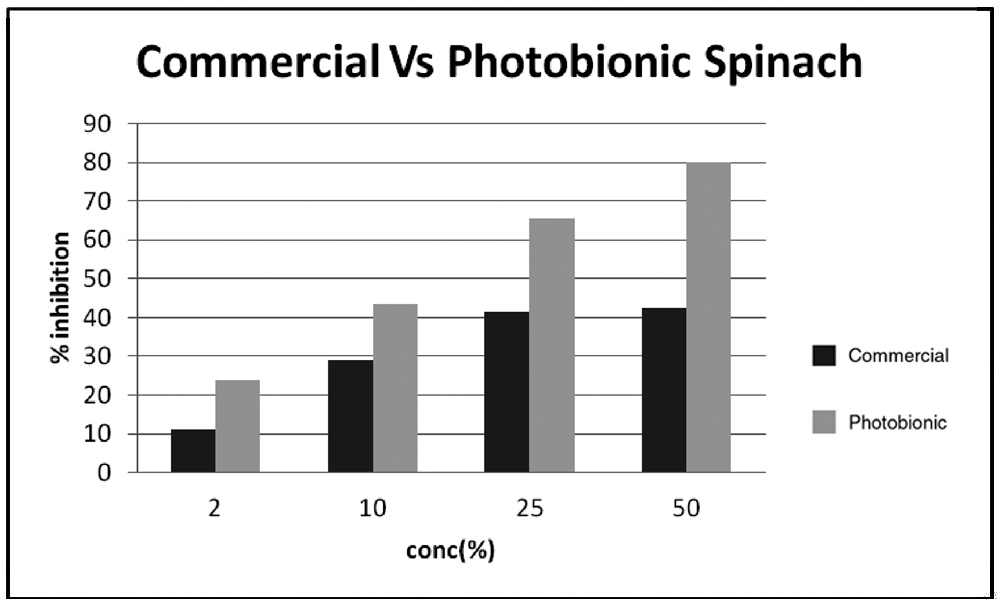
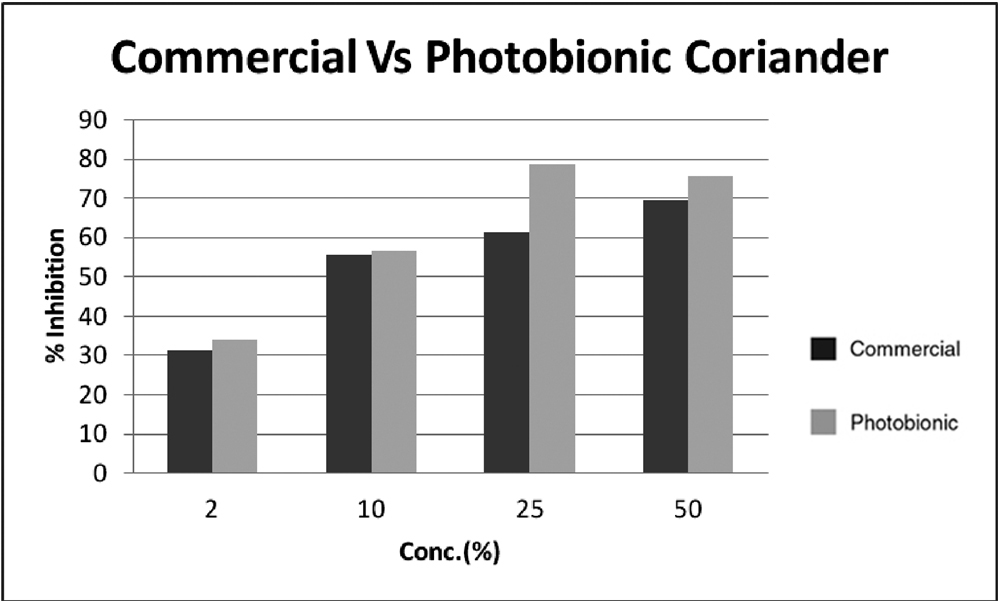
By comparing 50% concentrations of the extracts the potential based on a % inhibition of radicals could be expressed as follows:
Photobionic spinach is twice (1.88 times) as effective as the commercial variety.
Photobionic coriander is one time (1.08 times) more effective than the commercial variety.
Conclusion
The physical appearance as well as the increased shelf-life and better antioxidant ability of photobionically grown vegetables points out that this method is highly recommendable for commercial as well as for non-commercial purposes.
References
1. Caraka. Caraka saṁhitā, Sūtrasthāna, śloka 44, Volume 1 (Translated by P.V.Sharma). Varanasi: Chaukhambha Orientalia; 2005, p. 6.
2. Purani AB. Evening talks with Sri Aurobindo. 3rd ed. Pondicherry: Sri Aurobindo Society; 1995, p. 202.
3. Palla V. Photobionics — an innovative application of law of similars. NAMAH 2013; 21(3): 9-17.
4. Sagi AK. A comparative evaluation of the antioxidant potential of organic rice and a commercial variety NAMAH 2013; 21(3): 18-20.
5. Palla V. Photobionics — experiments and results. NAMAH 2014; 21(4):
20-6.
1 Red blood cells are the chief representative material for rakta dhātu, though rakta dhātu in tantric parlance means all the subtle energies that are manifest in the Nature that divinely inspire in the formation of rakta and its moods. The Swadhistana cakra is the seat for rakta dhātu.
2 White blood cells are the chief representative material for maṁsa dhātu, though maṁsa dhātu means the formative energies with their shape and ideation that predetermine the form of a being that might take a material form. The Manipura cakra is the seat for maṁsa dhātu.
3 Every chemical substance absorbs light at a specific wavelength. By using a UV -Visible spectrophotometer, the wavelength at which a substance absorbs the maximum light can be measured. In this experiment DPPH absorbs light at 517nanometers wavelength. So keeping 517nm constant, the absorbance value of DPPH at different concentrations with and without the test material, i.e extracts of leafy vegetables is observed. Depending on the radical scavenging potential of the extract, the absorbence can be noted from the instrument. As the extract scavenges DPPH radicals in the solution the absorbence decreases. Using this principle the absorbence of standard DPPH and inhibition of radicals after addition of extracts is compared and the antioxidant potential as a % inhibition of DPPH radicals is quantified.
Dr. Venkatesh Palla, a member of SAIIIHR, is a practising homoeopathic physician at Bhimavaram, Andhra Pradesh, India.
Dr. Anil Kumar Sagi is an Assistant Professor at the Shri Vishnu College of Pharmacy, Bhimavaram, Andhra Pradesh, India.
Share with us (Comments,contributions,opinions)
When reproducing this feature, please credit NAMAH,and give the byline. Please send us cuttings.

